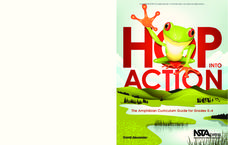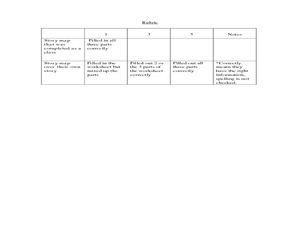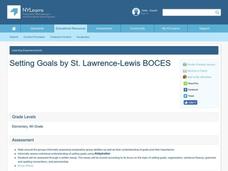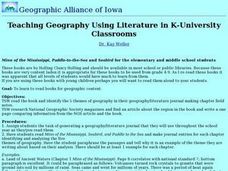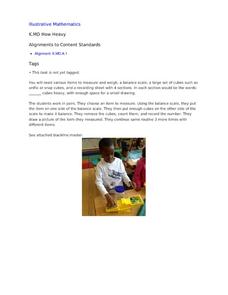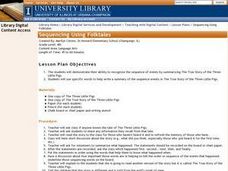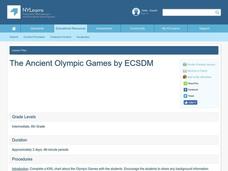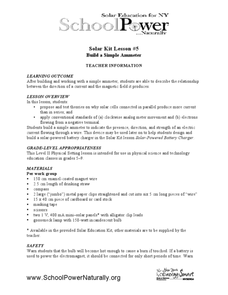Curated OER
Romeo and Juliet: To Tell, or Not to Tell
Should Romeo and Juliet have revealed their engagement to their parents? After reading Acts I and II of Shakespeare's Romeo and Juliet, your class discusses this question with a SMARTboard presentation (though the lesson still works...
National Science Teachers Association
Hop into Action
Young scientists find out what makes amphibians such unique and interesting animals in this simple life science lesson plan. After looking at pictures and discussing the characteristics of amphibians, learners complete a...
Curated OER
Story Stew
Students identify the elements of a story. In this reading and writing lesson, pupils read the book, Tyrone the Horrible by Hans Wihelm and then identify the characters, setting, and plot of the story.This lesson includes adaptations and...
Zaner-Bloser
Handwriting Evaluation Guide
Having trouble evaluating your kids' handwriting? Print an evaluation guide and match their writing to the excellent, good, average, fair, and poor samples.
Curated OER
The Progressive Era in Illinois
High schoolers collect photographs on the Progressive Era in Illinois, then write three newspaper articles, using one photo per article. The article will highlight an event in Illinois during the Progressive Era. The newspaper must also...
Curated OER
Student Newspaper Project
Writing teaches us so much. One can identify the many characteristics of a newspaper, use the Internet to gather information, and communicate with others. Primary students create a class newspaper for publishing and dispersal.
Curated OER
Setting Goals
Fourth graders view a PowerPoint presentation "Setting goals." They use Kidspiration to organize long and short term goals for academics. Students write essays about Goal Setting. Students work in groups and create a dialogue involving...
Curated OER
teaching Geography Using Literature in K-University Classrooms
Students read one of the following books: Minn of the Mississippi, Paddle-to-the-Sea, or Seabird, all by Holling C. Holling, and identify the five themes of geography as well as make a literature journal with chapter field notes. They...
Art Institute of Chicago
African Myths and Stories
Young historians discover African stories associated with a royal altar tusk from the Kingdom of Benin in Nigeria, read myths illustrated on the tusk, and write a story about the life of an oba using figures depicted on the tusk.
Curated OER
How Heavy
Break out the balances for this primary grade lesson on weight measurement. Using common elementary school manipulatives like unifix or snap cubes, young mathematicians determine the weight of four different classroom objects. A graphic...
Curated OER
Learning From the Past
Coming up on the Olympics? Be sure your middle schoolers understand the dynamic and ancient history of this global tradition. They begin by recalling traditions parents have passed down, considering their relevance and ways they might be...
Curated OER
The Noble Eightfold Path
Students gain an introduction to Buddhist teachings about moral behavior by exploring a depiction of the Buddha and by writing a speech inspired by their interpretation of the Noble Eightfold Path.
Curated OER
Current Events
Students explore different countries, their locations, and their cultures. Using an encyclopedia, they locate the information, then write a report. Ultimately, they create a paper doll to represent their chosen country.
Curated OER
Compare Two Versions: Folk Tales, Sequencing, and Summary
Compare two versions of "The Three Little Pigs" (traditional and Jon Scieszka's The True Story of the Three Little Pigs, told from the wolf's point of view). As your 4th graders recount the familiar version of the story, emphasize the...
Curated OER
The Art of Locomotion
Tenth graders examine the artistic legacy of trains by comparing the representations of trains in the painting of Turner and the photographs of Terry Evans. They write an essay, story or poem using their own observations of trains,...
Curated OER
Biography
Transform a written biography into a video biography! Introduce your learners to the biography format by reading them a few examples (some suggestions are included). Then discuss the factors that make a good biography. What information...
Curated OER
What's the Frequency, Roy G. Biv?
Introduce starting space scientists to the electromagnetic spectrum, expecially the portion of visible light. Teach them about wavelength and frequesncy. Then give them a roll of adding machine tape and a manila folder to make a...
Curated OER
Pride and Prejudice, Chapter XIV: Lady Catherine and Elizabeth
Is your class reading Pride and Prejudice? In order to link scenes to the themes in Austen's novel, pairs take on the confrontation between Lady Catherine and Elizabeth (Chapter XIV). After writing their own version of the...
Curated OER
Germs and the Importance of Washing Your Hands
Students observe what happens when bread is handled by dirty hands. They read and discuss the book "Germs." Students participate in an experiment. Students touch bread with a variation of hands: dirty, washed with soap and water, washed...
Curated OER
The Ancient Olympic Games
Sixth graders complete a KWL chart about the Olympic Games. They watch a PowerPoint presentation about ancient Olympics. Each student completes a worksheet during the PowerPoint. Students write a summary of the information presented...
Curated OER
The Land Around Us - Lesson 3
While the content of this lesson is more specific to the first grade, the directions given to work on a PowerPoint are well written. These directions could be used by anyone, with any content. Younger learners may need help reading the...
Curated OER
Solar Kit Lesson #5 - Build a Simple Ammeter
Emerging electricians build a simple ammeter for making measurements on an electric current. They test the placement of solar cells in both series and parallel circuits and examine the magnetic field produced by the movement of electrons...
Curated OER
Our Town: Using Song Lyrics in the Classroom
Bruce Springsteen’s “My Hometown” and Billy Joel’s “Allentown” motivate young lyricists to craft poems about their own home town. Groups compare the two songs, identifying details, symbols, and conflicts. Individuals then picture a place...
Hawaiʻi State Department of Education
Dance Critic
What do writing and dance have in common? They both have a six-trait rubric for assessment. Just like a good story, a good dance must have a hook, beginning, middle, end, logical sequence, and a climax. Learners use a...

